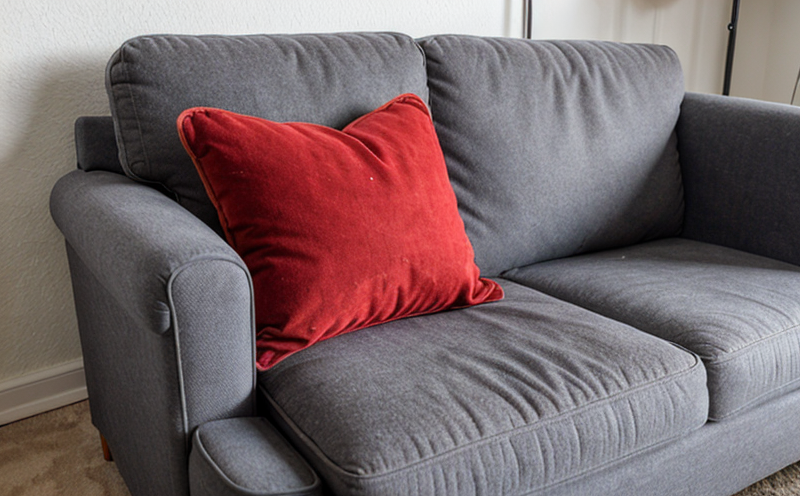ISO 16000-9 Indoor Air Emission Testing of Upholstered Cushions Materials
The ISO 16000-9 standard provides a robust method for evaluating the indoor air emissions from upholstered cushions materials. This testing is particularly important in sectors like furniture manufacturing and interior design, where ensuring the health and safety of end users is paramount. The test focuses on identifying volatile organic compounds (VOCs) that may be released into the air during use.
The process involves placing a specified sample of cushion material within a climate-controlled chamber for a set duration. During this period, the emission levels are continuously monitored using gas chromatography/mass spectrometry (GC/MS). The test aims to quantify the emissions in parts per million (ppm) and compare them against established thresholds.
The significance of this testing cannot be overstated, especially given the increasing awareness of indoor air quality issues. By adhering to ISO 16000-9 standards, manufacturers can ensure compliance with local regulations and build consumer trust by delivering products that are safe for residential use.
For furniture companies, this test is a critical step in their quality assurance process. It helps identify potential issues early in the production cycle, allowing for necessary adjustments to be made before large-scale manufacturing. Additionally, it provides valuable data that can inform product design and materials selection, ensuring that the final products meet not only regulatory requirements but also exceed customer expectations.
The ISO 16000-9 protocol is widely recognized as a reliable method for evaluating indoor air emissions from upholstered cushion materials. Its standardized approach ensures consistent results across different laboratories and regions, making it an essential tool for manufacturers operating in diverse markets.
In summary, the ISO 16000-9 test serves multiple purposes: it identifies potential health hazards associated with the use of certain materials; it supports regulatory compliance; and most importantly, it enhances overall product quality by ensuring that emissions are kept within safe limits. This comprehensive testing method is crucial for any company involved in furniture manufacturing or related industries.
Why Choose This Test
Selecting ISO 16000-9 indoor air emission testing for your cushion materials offers several advantages that can significantly impact the quality and reputation of your products:
- Regulatory Compliance: Ensures adherence to international standards, which is crucial for companies operating in multiple regions.
- Health & Safety: Identifies potential risks early in the production process, protecting both consumers and workers from exposure to harmful chemicals.
- Product Quality: Provides detailed information about emissions that can guide material selection and improve overall product performance.
- Customer Satisfaction: Builds trust with customers by demonstrating a commitment to producing safe and high-quality products.
The test also provides valuable insights into the environmental impact of your materials, which is increasingly important as sustainability becomes a key concern for many industries. By choosing this test, you are investing in the future success of your business through improved product quality and enhanced customer satisfaction.
Customer Impact and Satisfaction
The ISO 16000-9 test plays a vital role in enhancing customer trust and satisfaction by ensuring that products meet stringent safety standards. For consumers, this means peace of mind knowing that the furniture they purchase is free from harmful chemicals. This can lead to increased brand loyalty and positive word-of-mouth recommendations.
For businesses, meeting these standards translates into better relationships with suppliers who also adhere to high-quality practices. It fosters a culture of continuous improvement within your organization, encouraging innovation in product development while maintaining the highest levels of quality control.
The results from this testing can be shared with customers during sales processes or on product literature, further emphasizing your commitment to excellence. This transparency not only enhances customer satisfaction but also sets you apart as an industry leader committed to sustainability and safety.
Environmental and Sustainability Contributions
The ISO 16000-9 test contributes significantly to environmental protection efforts by helping manufacturers reduce the release of harmful chemicals into the environment. By identifying emissions early in the production process, companies can take proactive steps towards minimizing their ecological footprint.
This testing aligns with broader sustainability goals by promoting the use of eco-friendly materials and manufacturing processes. It supports initiatives aimed at reducing waste, conserving resources, and lowering carbon footprints throughout the supply chain.
Moreover, compliance with such standards can help companies qualify for various certifications that recognize their commitment to environmental responsibility. These credentials not only enhance corporate reputation but also open up new market opportunities in sectors prioritizing sustainability.





